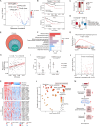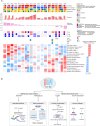Proteogenomic characterization of skull-base chordoma
- PMID: 39333076
- PMCID: PMC11436687
- DOI: 10.1038/s41467-024-52285-7
Proteogenomic characterization of skull-base chordoma
Abstract
Skull-base chordoma is a rare, aggressive bone cancer with a high recurrence rate. Despite advances in genomic studies, its molecular characteristics and effective therapies remain unknown. Here, we conduct integrative genomics, transcriptomics, proteomics, and phosphoproteomics analyses of 187 skull-base chordoma tumors. In our study, chromosome instability is identified as a prognostic predictor and potential therapeutic target. Multi-omics data reveals downstream effects of chromosome instability, with RPRD1B as a putative target for radiotherapy-resistant patients. Chromosome 1q gain, associated with chromosome instability and upregulated mitochondrial functions, lead to poorer clinical outcomes. Immune subtyping identify an immune cold subtype linked to chromosome 9p/10q loss and immune evasion. Proteomics-based classification reveals subtypes (P-II and P-III) with high chromosome instability and immune cold features, with P-II tumors showing increased invasiveness. These findings, confirmed in 17 paired samples, provide insights into the biology and treatment of skull-base chordoma.
© 2024. The Author(s).
Conflict of interest statement
The authors declare no competing interests.
Figures







References
-
- Walcott, B. P. et al. Chordoma: current concepts, management, and future directions. Lancet Oncol.13, e69–e76 (2012). - PubMed
-
- Crockard, H. A. et al. A multidisciplinary team approach to skull base chordomas. J. Neurosurg.95, 175–183 (2001). - PubMed
-
- Stacchiotti, S. & Sommer, J. Building a global consensus approach to chordoma: a position paper from the medical and patient community. Lancet Oncol.16, e71–e83 (2015). - PubMed
Publication types
MeSH terms
LinkOut - more resources
Full Text Sources

